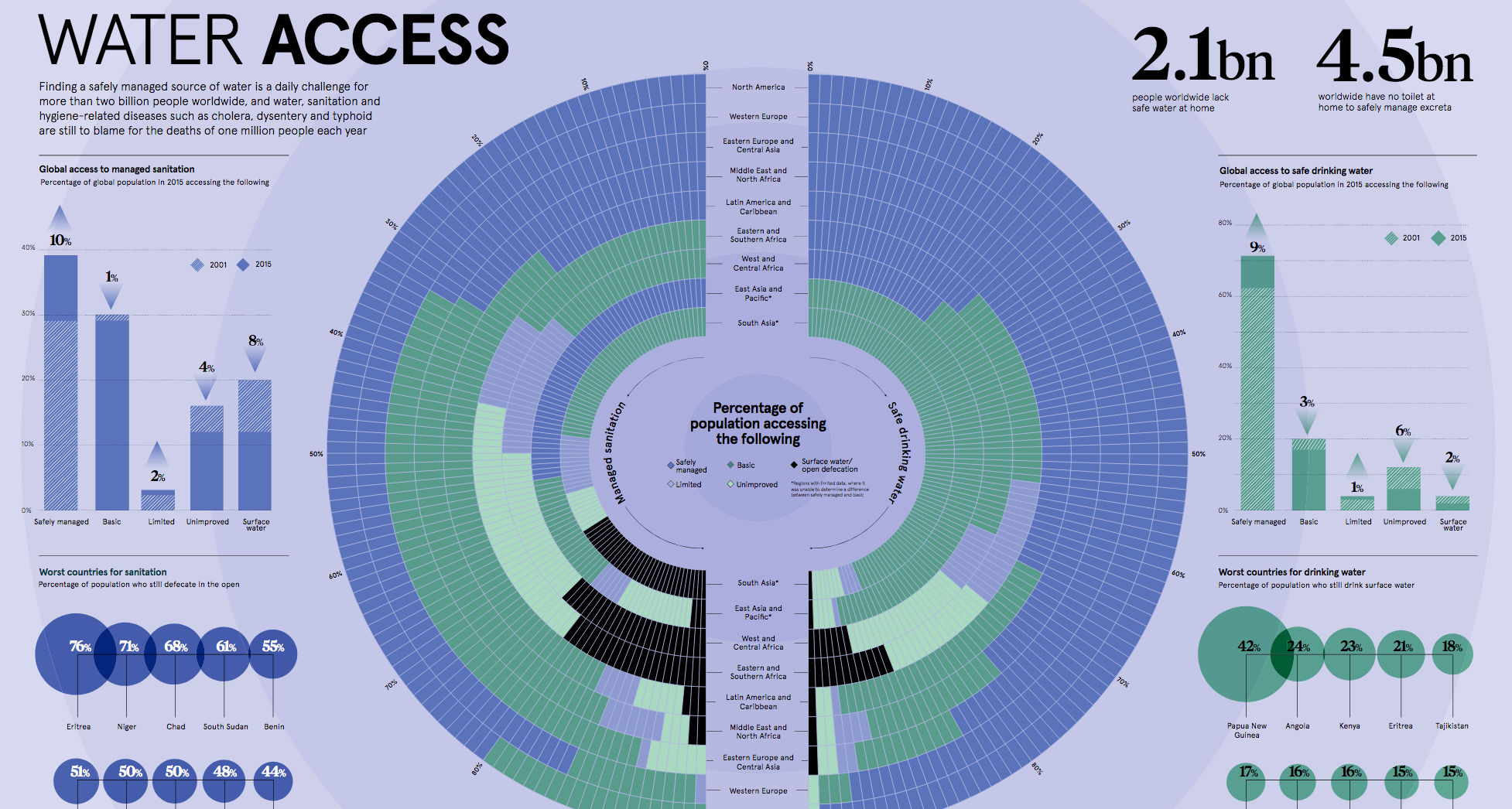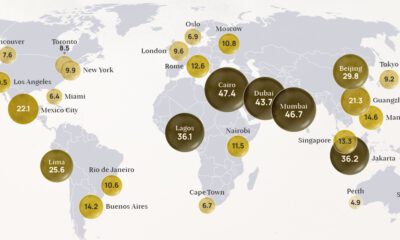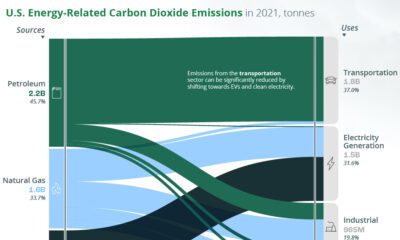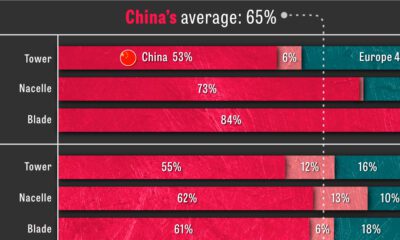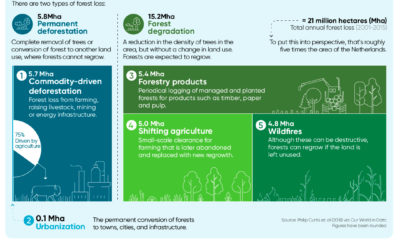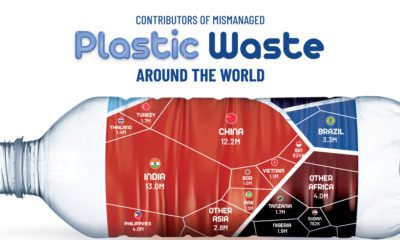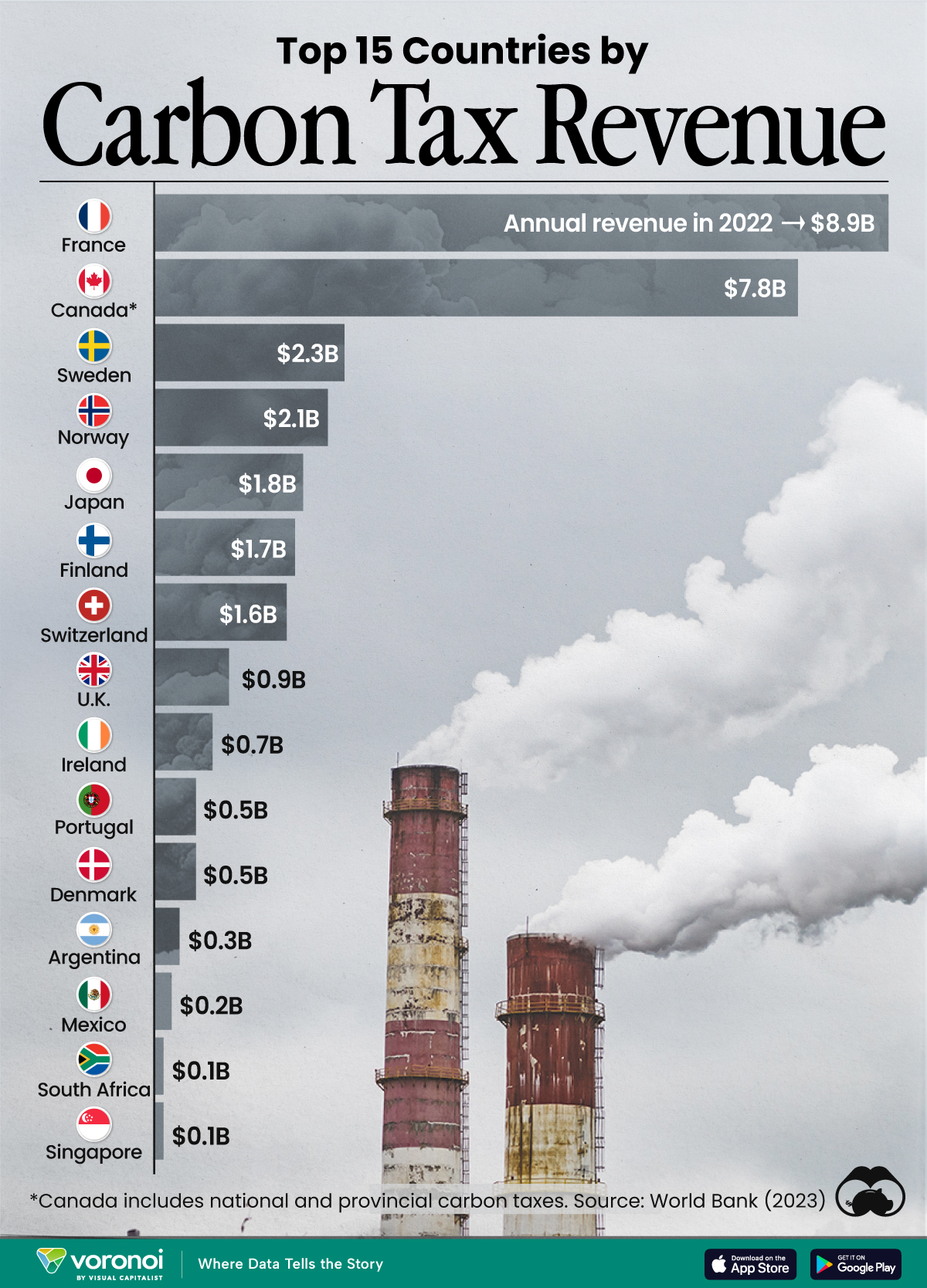Green
The World’s Water Access in One Visualization
View a high resolution version of this graphic.
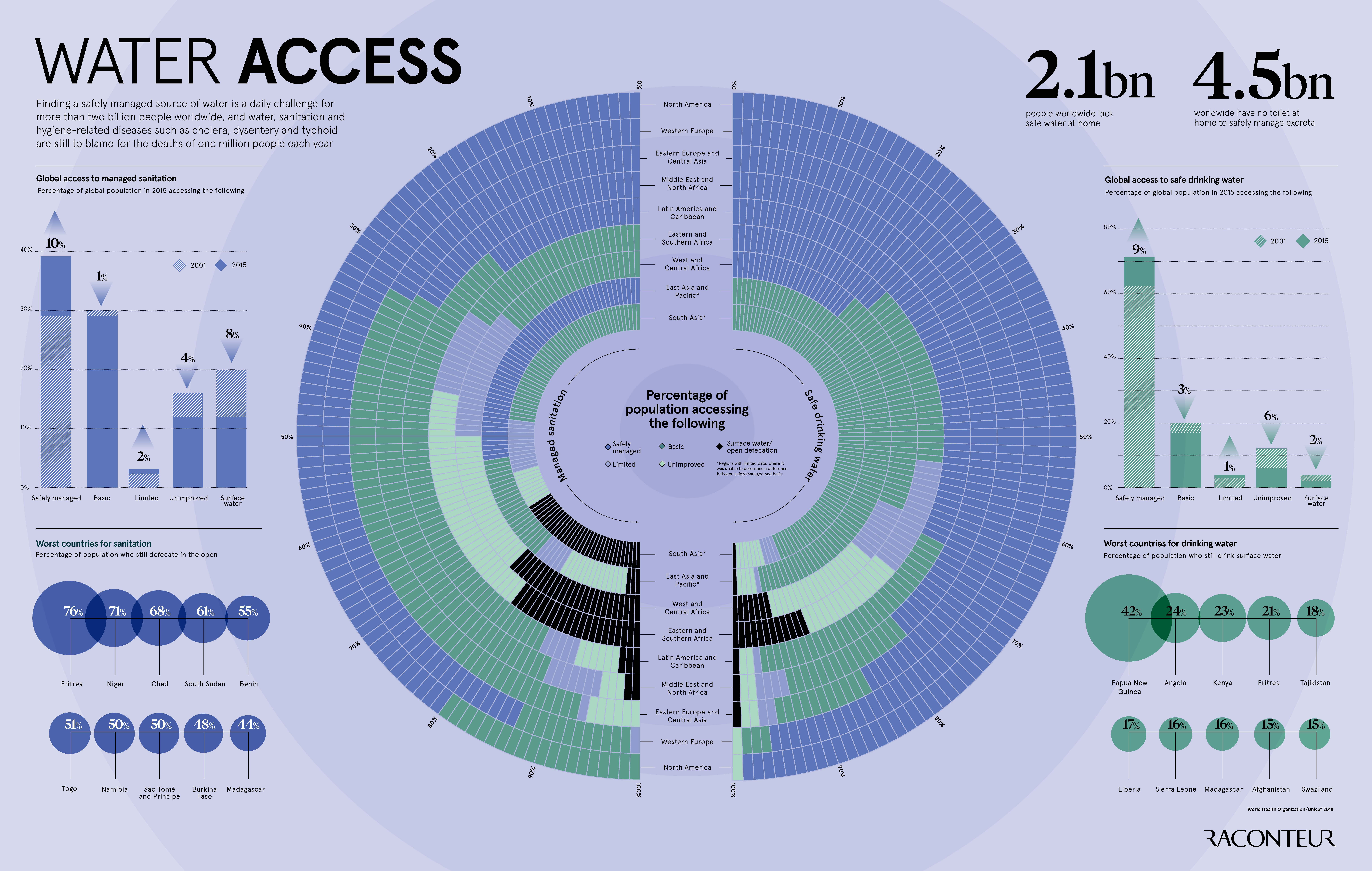
The World’s Water Access in One Visualization
View the high resolution version of today’s graphic by clicking here.
Water is the world’s most vital resource. Beyond its basic functions of sustaining life, it’s also a precious commodity – one that billions of people in the world have trouble accessing.
Today’s infographic is from Raconteur, and it puts the global issue of water access into staggering perspective. It’s a two-fold problem: safe drinking water is hard to come by, while basic access to sanitation is less common than you’d expect.
Diving into Drinking Water
It’s easy to take water for granted when it comes out of every tap in developed economies, but the stark reality is that 2.1 billion people worldwide can’t get safe water this way.
Many people in the world spend hours waiting in long lines, often multiple times a day, for community-shared water, or, they have to travel to distant sources just to collect it.
World regions are categorized according to five classifications for drinking water access.
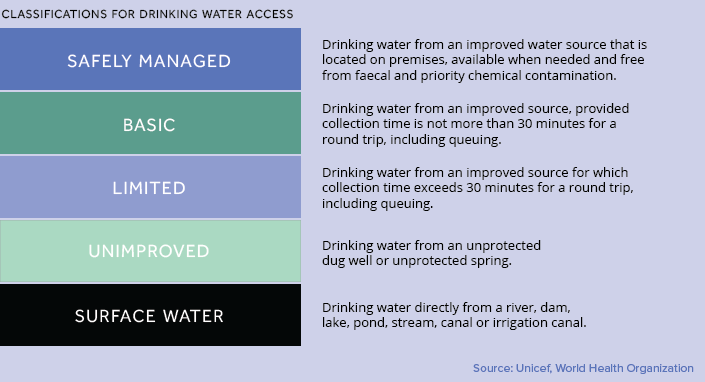
Here’s a breakdown of how each region fares.
| Region | Safely Managed | Basic | Limited | Unimproved | Surface Water |
|---|---|---|---|---|---|
| North America | 99% | - | - | 1% | - |
| Western Europe | 96% | 3% | - | 1% | - |
| Eastern Europe and Central Asia | 84% | 11% | 2% | 2% | 1% |
| Middle East and North Africa | 77% | 16% | 4% | 2% | 1% |
| Latin America and Caribbean | 65% | 31% | 1% | 2% | 1% |
| Eastern and Southern Africa | 26% | 28% | 18% | 16% | 12% |
| West and Central Africa | 23% | 40% | 10% | 20% | 7% |
| East Asia and Pacific | - | 94% | 1% | 4% | 1% |
| South Asia | - | 88% | 4% | 7% | 1% |
The water crisis in Flint, Michigan is a dire exception to the safely managed water rule in North America. After a change in river source in 2014, insufficient water treatment resulted in lead from pipes leaching into the drinking water, affecting over 100,000 residents.
The Struggle of Sanitation
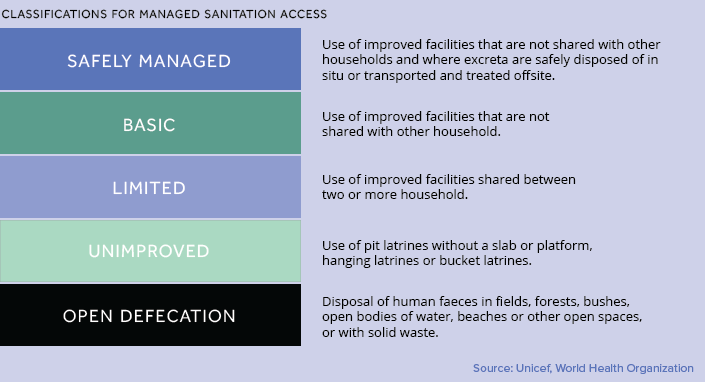
The invention of the toilet in 1875 is credited with saving one billion lives to date. Yet, poor water hygiene and its associated diseases claim the lives of roughly one million people annually.
This is because roughly 4.5 billion people still don’t have access to a toilet, with the problem being particularly acute on the African continent. More than half of the population in Eritrea (76%), Niger (71%), Chad (68%) and South Sudan (61%), for example, do not have any access to even basic sanitation.
Every Drop of Water Counts
According to the World Economic Forum, water has been a top-five global risk for the past seven years.
From an economic perspective, it’s easy to see why:
- An estimated $260 billion is lost globally each year from the lack of basic water and sanitation.
- Almost $18.5 billion in benefits can come from universal access to basic water and sanitation.
Securing water access has profound consequences. For every $1 invested in water and sanitation, there’s a $4 return from lower health costs, higher productivity, and fewer preventable deaths.
Fortunately, progress is being made on the global scale. Between 2001 and 2015, there’s been a 9% improvement in safe drinking water, while safely managed sanitation has risen by 10%.
Green
Ranking the Top 15 Countries by Carbon Tax Revenue
This graphic highlights France and Canada as the global leaders when it comes to generating carbon tax revenue.
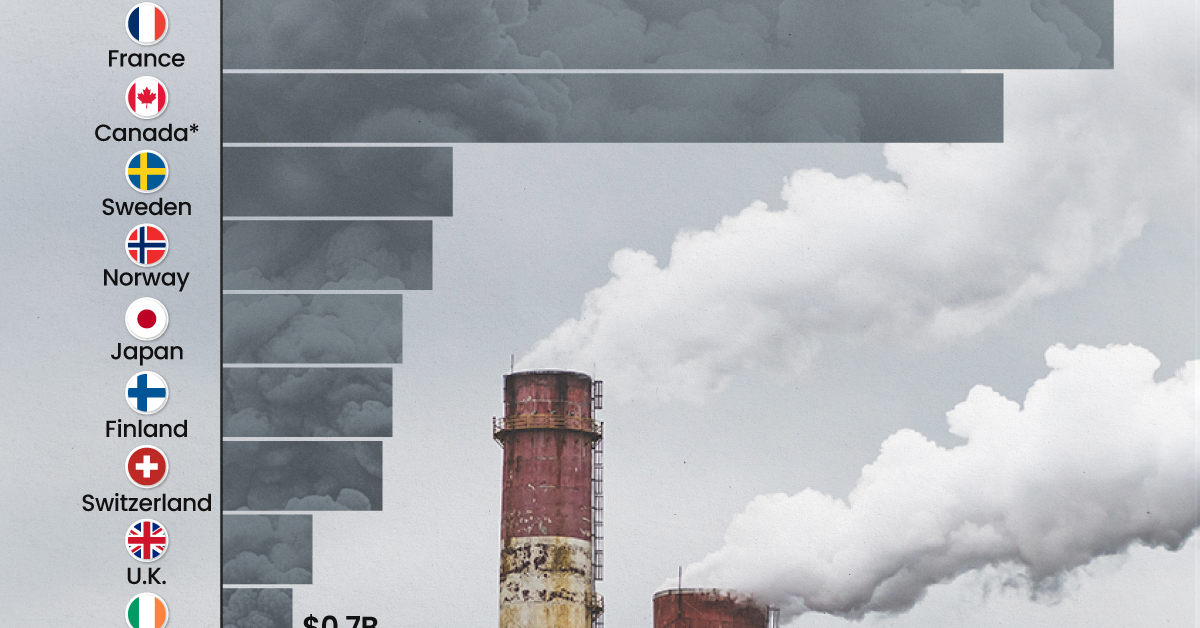
Top 15 Countries by Carbon Tax Revenue
This was originally posted on our Voronoi app. Download the app for free on iOS or Android and discover incredible data-driven charts from a variety of trusted sources.
Carbon taxes are designed to discourage CO2 emissions by increasing the cost of carbon-intensive activities and incentivizing the adoption of cleaner energy alternatives.
In this graphic we list the top 15 countries by carbon tax revenue as of 2022. The data is from the World Bank’s State and Trends of Carbon Pricing Report, published in April 2023.
France and Canada Lead in Global Carbon Tax Revenue
In 2022, the top 15 countries generated approximately $30 billion in revenue from carbon taxes.
France and Canada lead in this regard, accounting for over half of the total amount. Both countries have implemented comprehensive carbon pricing systems that cover a wide range of sectors, including transportation and industry, and they have set relatively high carbon tax rates.
| Country | Government revenue in 2022 ($ billions) |
|---|---|
| 🇫🇷 France | $8.9 |
| 🇨🇦 Canada | $7.8 |
| 🇸🇪 Sweden | $2.3 |
| 🇳🇴 Norway | $2.1 |
| 🇯🇵 Japan | $1.8 |
| 🇫🇮 Finland | $1.7 |
| 🇨🇭 Switzerland | $1.6 |
| 🇬🇧 United Kingdom | $0.9 |
| 🇮🇪 Ireland | $0.7 |
| 🇩🇰 Denmark | $0.5 |
| 🇵🇹 Portugal | $0.5 |
| 🇦🇷 Argentina | $0.3 |
| 🇲🇽 Mexico | $0.2 |
| 🇸🇬 Singapore | $0.1 |
| 🇿🇦 South Africa | $0.1 |
In Canada, the total carbon tax revenue includes both national and provincial taxes.
While carbon pricing has been recognized internationally as one of the more efficient mechanisms for reducing CO2 emissions, research is divided over what the global average carbon price should be to achieve the goals of the Paris Climate Agreement, which aims to limit global warming to 1.5–2°C by 2100 relative to pre-industrial levels.
A recent study has shown that carbon pricing must be supported by other policy measures and innovations. According to a report from Queen’s University, there is no feasible carbon pricing scenario that is high enough to limit emissions sufficiently to achieve anything below 2.4°C warming on its own.
-

 Green2 weeks ago
Green2 weeks agoRanked: Top Countries by Total Forest Loss Since 2001
-

 Travel1 week ago
Travel1 week agoRanked: The World’s Top Flight Routes, by Revenue
-

 Technology1 week ago
Technology1 week agoRanked: Semiconductor Companies by Industry Revenue Share
-

 Money2 weeks ago
Money2 weeks agoWhich States Have the Highest Minimum Wage in America?
-

 Real Estate2 weeks ago
Real Estate2 weeks agoRanked: The Most Valuable Housing Markets in America
-

 Markets2 weeks ago
Markets2 weeks agoCharted: Big Four Market Share by S&P 500 Audits
-

 AI2 weeks ago
AI2 weeks agoThe Stock Performance of U.S. Chipmakers So Far in 2024
-

 Automotive2 weeks ago
Automotive2 weeks agoAlmost Every EV Stock is Down After Q1 2024

